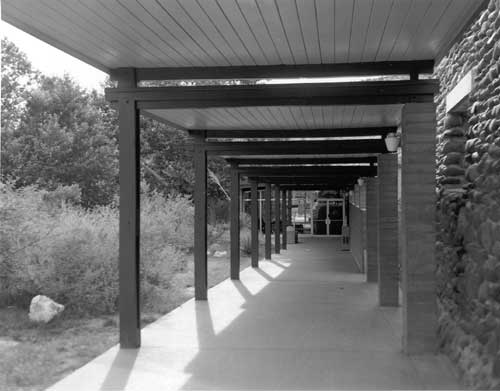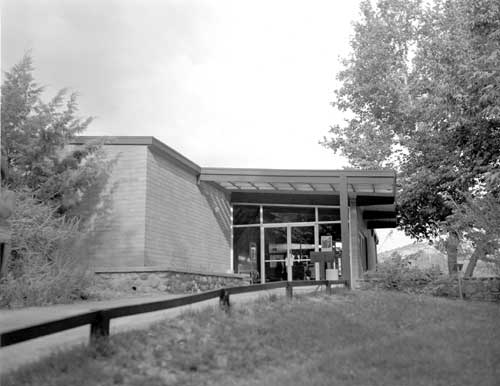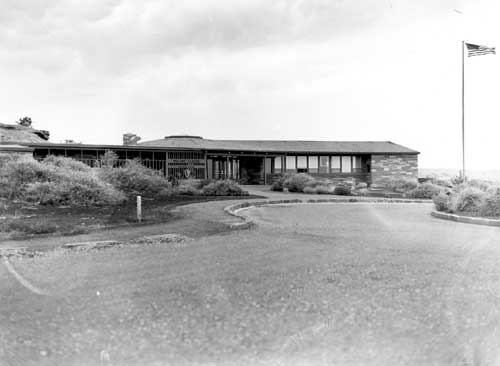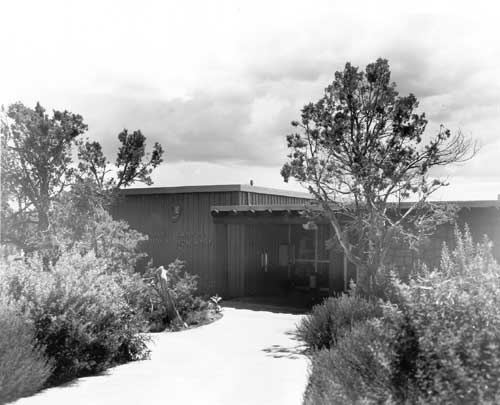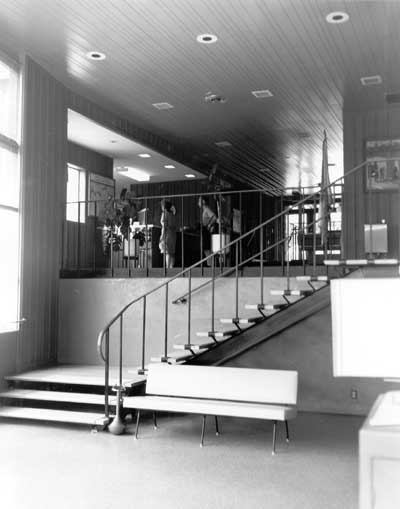MENU
Cecil Doty
| Mission
66 Visitor Centers
Chapter 6 |

|
Three Southwestern Visitor Centers
During the Mission 66 program Doty designed visitor centers for a range of climates and locations, according to varying needs and anticipated visitation. In some cases, he never visited the site, and in others, he executed final working drawings. Rather than compare such a divergent group of designs, this section will look more closely at three small visitor centers in Arizona, all serving as the gateway to ancient ruins. In the design of these modest buildings for relatively obscure parks, Doty shows his versatility in adapting to site conditions. At Montezuma Castle and Wupatki Ruins, the buildings are located on pathways to the ancient structures. Doty had no choice but to build at the edge of Walnut Canyon, where an existing building provided the foundation for his modern addition. The three visitor centers illustrate the extent to which terrain and natural surroundings influence the perception of modern park buildings. Modern architecture is most successful in places where the site obscures and overwhelms—such as Montezuma Castle—and when it clearly uses modern technology to advantage by providing more dramatic viewing opportunities—such as Walnut Canyon.
Figure 72. Entrance to Montezuma Castle Visitor Center, 1969.
(Courtesy Technical Information Center, Denver Service Center.)The visitor center at Montezuma Castle, designed by Doty in 1958, is so shaded by native trees and the adjacent hillside that architectural style is hardly an issue. In this design, Doty had the foresight not to place the building in an open clearing, but to wedge it into the canyon, longwise. The visitor follows the path from parking lot to restrooms, and then continues to the lobby entrance. The information desk is to the right of the door, but open to the entire space, which includes a sales area and exhibits. Park offices are entered from behind the desk. The dark, enclosed space seems appropriate in this narrow site, and actually pushes the visitor towards the far end of the lobby, where a door leads out to the ruins. A concrete path winds the half mile to the ruins and continues in a short loop around the canyon. The visitor center includes an adjacent terrace with serpentine curb that overlooks a shaded picnic area. The terrace was paved around trees, which now appear to grow from the concrete. On paper, the flat-roofed metal-and-glass building appears a quintessential modernist facility, but in fact, the building is a remarkable example of how modern architecture can actually fade into the background. Little needs to be said about Walnut Canyon—a visitor center almost impossible to photograph—because it so deliberately and successfully attracts little notice.
Figure 73. Montezuma Castle Visitor Center, rear entrance and path to ruins, 1969.
(Courtesy Technical Information Center, Denver Service Center.)At Wupatki Ruins, Doty confronted a more open, high desert landscape that he had studied before. Wupatki is one of several sites in northern Arizona featuring significant ruins of ancient Indian communities. Although most of these ruins are cliff dwellings, such as those hunkering down in the valley at Canyon de Chelly, Montezuma Castle, and nearby Walnut Canyon, the remains at Wupatki rise from a relatively flat area; the ancient settlement's free-standing walls stand exposed upon the rocky high desert. In the early 1940s, Doty had designed a small administration building at the monument. His solution to the siting problem involved constructing the building up against a nearby rock formation. This early design was considered an extension of an existing residential building, even though a patio separated the structures. The new visitor center was to be an enlargement of this early administrative facility. In his original design, Doty had cultivated the familiar southwestern theme, creating a rough masonry building with carved wooden corbels under the eaves, exposed vigas, and canales. His Mission 66 addition effectively obliterated the older building, as it shifted to an abstract version of Native American architecture, imitating both the nearby stonework and the traditional methods of residential construction. The "hogan" shape of the lobby with its central skylight was a reoccurring spatial motif in Doty's visitor centers. Along with its relatives the kiva and teepee, this glass-covered cone was considered appropriate for many situations involving Indian heritage in western and southwestern states.
In May 1957, several years before Doty arrived on the scene, Wupatki mounted a promotional Mission 66 display. The introductory panel explained that, "in this exhibit Wupatki will be used as an example of what needs to be done in Arizona and throughout the United States Parks and Monuments." [24] Successive panels commented on the importance of Mission 66 as a method of preservation. [25] Finally, in November 1961, Doty visited the site in preparation for the long anticipated visitor center, scheduled for construction in 1963. [26] Six months later, Superintendent Russell L. Mahan praised "Architect Doty, WODC" for submitting an excellent floor plan. Mahan approved the preliminary plans with only minor suggestions and looked forward to the start of the spring construction season. [27] In December, Park Service representatives from the WODC and architects Leslie J. Mahoney and R. Gilman visited Wupatki to discuss the site and potential building materials. The firm of Lescher and Mahoney, Phoenix, which received the contract for final drawings, had already completed similar work for the Park Service at Organ Pipe Cactus, Arizona, (1956-1958) and was involved in the additions and alterations at Casa Grande (1962-1963).
Bids for the construction of the visitor center were first opened in July 1963, but higher than anticipated costs forced the park to delay the bidding process until September. [28] Work began on July 6, and, by end of month, footings had been poured and forming begun on foundations. [29]
The design of the visitor center at Wupatki Ruins is an excellent example of how the Park Service typically handled small Mission 66 projects at the height of the improvement program. Doty sketched two sheets of preliminary plans and the contract architects filled in the details. Whereas Doty simply labeled the central space "lobby" and "exhibits," separated by "skylites," Lescher and Mahoney indicated precise measurements, wall panels, construction details, and the 4,905-foot elevation. Although Doty's sketches give a better sense of the final building, the architects' plans provide the contractors with the information to actually build it. Like most of the visitor centers protecting ancient ruins, the Wupatki building blocks the view of the featured attraction. A flagstone path leads to the front entrance and the restrooms, entered from a sheltered walkway to the left of the building. Immediately upon entering, the visitor confronts an information counter on the right, adjacent the office wing. The octagonal lobby is illuminated by a central skylight divided by a partition separating exhibits from the sales area. Doors at the far end of the room lead to a flagstone patio and path to the ruins. The information counter stands guard next to the office wing, equipped with space for rangers, clerical work, and the superintendent's office. The park's historical archives are stored in part of the old building at the end of the path leading to the restrooms.
Figure 74. Visitor Center, Wupatki Ruins, near Flagstaff, Arizona.
(Courtesy National Park Service Technical Information Center, Denver Service Center.)From Doty's drawings, one imagines an even more modernistic building than that actually built. The exterior appears covered by a wall of vertical louvers, the office windows are severe; in plan, the central serving area and office appendages suggest a complicated building program. Actually, the Wupatki Visitor Center is small, simple, and understated. It fits in nicely with the nearby residential buildings and surrounding landscape, in part because one side of the building is pushed up against the rock hillside and existing administration building. Inside the lobby, the architect specified paneling of warm, western pine and a cedar information desk. Wupatki illustrates the positive and negative aspects of the Mission 66 plan. In achieving the goal of a simple architectural style with little impact on the landscape, Mission 66 designers created buildings almost too plain to criticize. They fulfill their function within budget, but hardly inspire. And yet, Doty's plan manages to use the original building—essentially a basement in the hillside—without inheriting the gloom and dank of this space. The Mission 66 goal was to solve the problems of visitor service and circulation, after all, and these requirements are certainly satisfied.
The Mission 66 visitor center at Walnut Canyon was also an addition to a building designed in the CCC era. During the planning phase, Doty and Vint visited the old building on the edge of a valley overlooking an intricate series of cliff dwellings. Doty remembered enthusiastically "talking about how you could do this and you could do that [with a new building]." Vint reminded him of the visitor center's practical function, which was not intended to showcase an architect's skill. [30] With this advice in mind, Doty went on to transform the older building with a glassed-in observation deck. The visitor center at Walnut Canyon took advantage of its site by bringing the visitor from the entrance down stairs to the lower viewing level, a series of terraces that imitated the natural surroundings. From here, the visitor confronted the spectacular canyon, as well as outdoor viewing opportunities.
Figure 75. Visitor Center, Walnut Canyon National Monument, near Flagstaff, Arizona.
(Courtesy National Park Service Technical Information Center, Denver Service Center.)More than the Wupatki addition, the extension of the administration building at Walnut Canyon allowed for an advantageous use of modern architecture in the expansive lobby viewing area. In cases such as these, the modernist style extended the boundaries of a space, actually opening up a window on the site. However, when such opportunities didn't present themselves, it was difficult to create a visually interesting building. Rustic architecture had the advantage of incorporating a certain amount of fantasy into its walls and appealing to stereotypes of the wild, rugged West. The rejection of this style also represented the beginning of a more serious attitude towards preservation and interpretation. Park Service Rustic was the architectural equivalent of "living history," a method of visitor entertainment the Park Service hoped to substitute with informative literature and educational programs. The very roots of modernism were founded in standardization, the attempt to create mass-produced housing for example, and, as a style, its use mirrored the Park Service's massive effort to provide adequate visitor services at every national park.
Figure 76. View of lobby from observation area, looking towards entrance, Walnut Canyon National Monument.
(Courtesy National Park Service Technical Information Center, Denver Service Center.)
|
History | Links to the Past | National Park Service | Search | Contact |
http://www.cr.nps.gov/history/online_books/allaback/vc6e.htm
![]()
